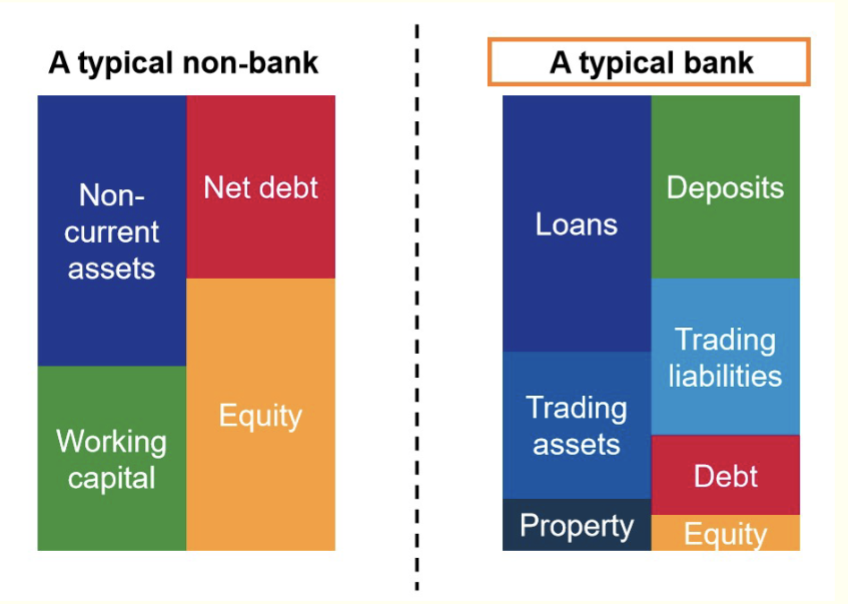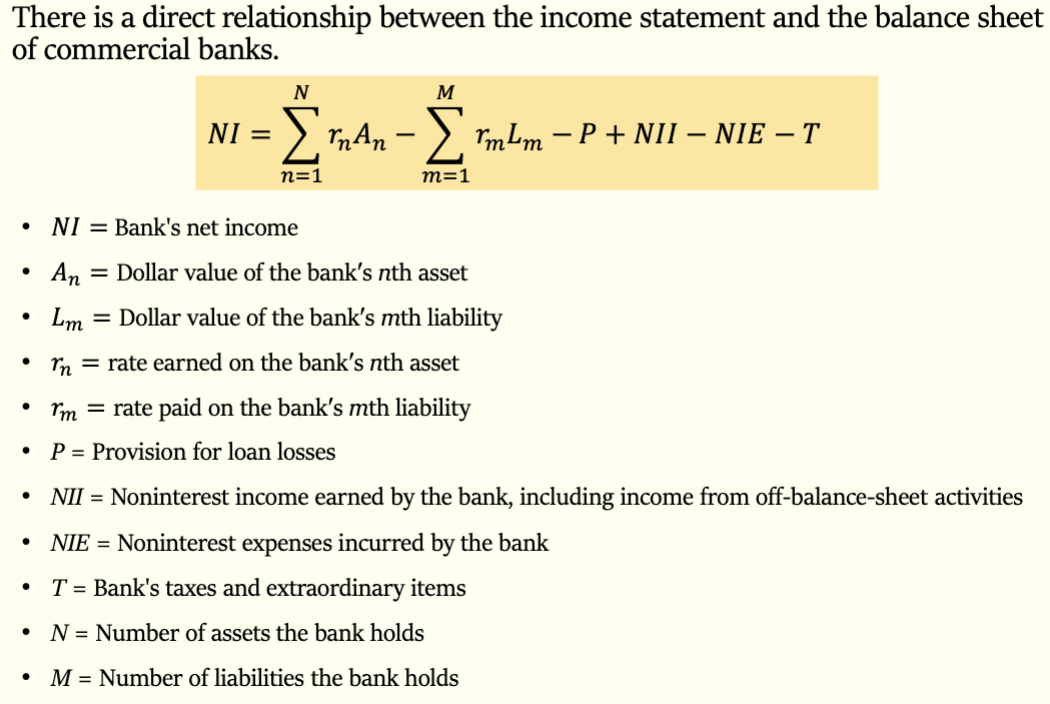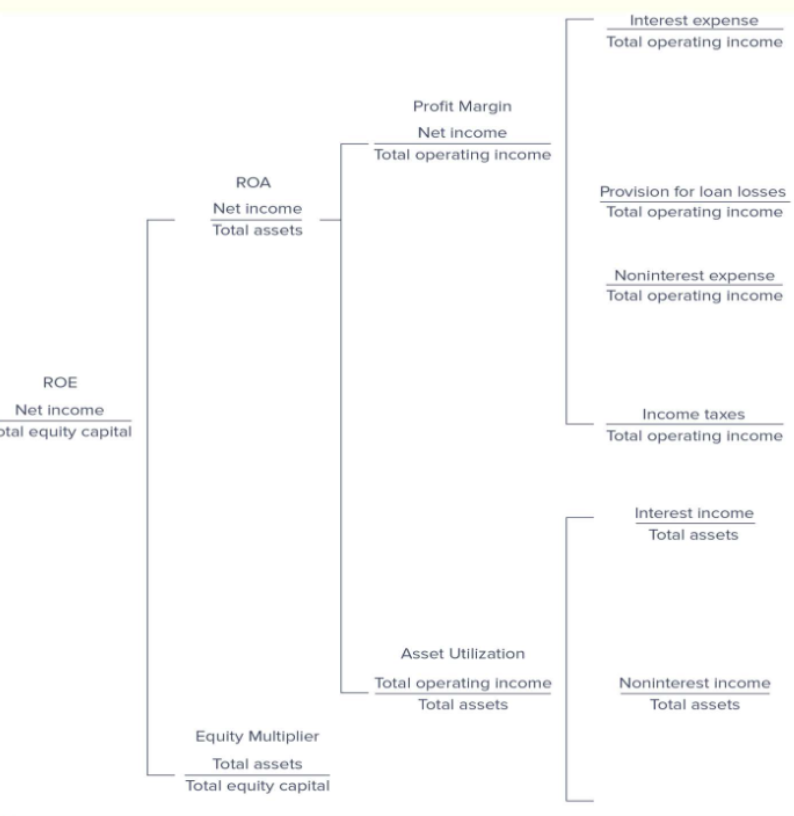Commercial Banks - Financial Statement Analysis
1/57
There's no tags or description
Looks like no tags are added yet.
Name | Mastery | Learn | Test | Matching | Spaced |
|---|
No study sessions yet.
58 Terms
Non Bank vs. Bank Balance sheet

Federal financial institutions examination council (FFIEC)
Federal Financial Institutions Examination Council (FFIEC) in the
US prescribes uniform principles, standards, and report forms for
depository institutions.
Who do Central Banks submit financial statements to?
Financial statements of CB’s must be submitted to regulators and
stockholders at the end of each calendar quarter.
Call Report
Financial information on CB’s is reported in two basic documents, called Call Report
Report of condition (or balance sheet) presents financial information on a bank’s
assets, liabilities, and equity capital.
Report of income (or income statement) presents major categories of revenues and
expenses and the net profit (or loss) for a bank over a period of time.
All FI’s, and particularly commercial banks, are engaging an an increased level of off-balance-sheet (OBS) activities.
Assets: Cash and due from depository institutions
Consists of vault cash, deposits at the Federal Reserve, deposits at
other financial institutions, and cash items in the process of
collection.
None of these generates much income for the bank.
Assets: Investment securities
Consists of federal funds sold, repurchase agreements (RP’s or
repos), U.S. Treasury and agency securities, securities issued by
states and political subdivisions (municipals), mortgage-backed
securities, and other debt and equity securities.
Highly liquid, low default risk, and can usually be traded in
secondary markets.
Generate some income for the bank but predominantly used for
liquidity risk management purposes.
Assets: Loans and leases.
Categorized as commercial and industrial (C&I) loans, loans secured by
real estate, individual or consumer loans, and other loans.
Major asset items on the bank’s balance sheet and generate the largest
flow of revenue income.
Least liquid asset items and a major source of credit and liquidity risk for
most banks.
Assets: Other Assets
Consists of items such as trading assets, premises and fixed assets, other
real estate owned, intangible assets, and other.
Generally a small part of the bank’s overall assets
Assets: Earning assets
Investment securities plus net loans and leases.
Liabilities
Liabilities consist of various types of deposit accounts and
other borrowings used to fund the investments and loans
on the asset side of the balance sheet.
Liabilities: Deposits
Demand deposits are transaction accounts that generally pay no
explicit interest.
Negotiable order of withdrawal (NOW) accounts pay interest
when a minimum balance is maintained.
Money market deposit accounts (MMDA’s) have retail savings
accounts and some limited checking account features.
Other savings deposits include all savings accounts other than
MMDA’s.
Deposits in foreign offices
Deposits in foreign offices are generally large and held by
corporations with a high level of international transactions and
activities.
Retail certificates of deposits
Retail certificates of deposits (CD’s) are time deposits with a face value below $100,000.
Wholesale certificates of deposits (CD’s)
Wholesale certificates of deposits (CD’s) are time deposits with a face value of $100,000 or more.
Negotiable instrumenets
Negotiable instruments, meaning they can be resold by title assignment in a secondary market to other investors.
Brokered deposits
If wholesale CD’s are obtained through a brokerage or investment house rather than directly from a customer, they are referred to as brokered deposits.
Liabilities: Borrowed Funds
• Federal funds.
• Repurchase agreements (R P’s or repos).
• Other borrowing: Banker’s acceptances (BA’s), commercial paper, medium-
term notes, and discount window loans.
Liabilities: Core deposits
Core deposits: sum of demand deposits, NOW accounts, MMDAs,
other savings accounts, and retail CDs.
Liabilities: Purchased funds
Sum of brokered deposits, wholesale CDs,
deposits at foreign offices, fed funds purchased, repos, and
subordinated notes and debentures.
Purchased funds can be more expensive and more volatile sources of
funds than core deposits
Core deposits
Core deposits are the cheapest, and most stable, funds and are deposits that are at
the bank for reasons other than earning interest. Earning interest may still be
important but convenience, a relationship with the bank, customer satisfaction, etc.
keep the customer at the bank even if the bank does not pay the highest rate of
interest available on similar accounts at other banks.
Liabilities: Other liabilities
• Do not require interest to be paid.
• Accrued interest, deferred taxes, dividends payable, minority
interests in consolidates subsidies, and other miscellaneous claims.
Liabilities: Equity Capital
• Preferred and common stock (at par value).
• Surplus and additional paid-in capital (capital raised by selling shares
above the par value).
• Retained earnings
Loan Commitments
• are contractual commitments to loan to a firm a certain
maximum amount at given interest rate terms.
• Bank may charge up-front fee and/or commitment fee.
• Only when the borrower draws on the commitment do the
loans made under the commitment appear on the balance
sheet.
• A commitment fee is the fee charged on the unused
component of a loan commitment.
• By providing liquidity to depositors and credit-lines to borrowers,
banks can be exposed to double-runs on assets and liabilities.
Off balance sheet items
Off-balance-sheet items are contingent assets and liabilities
that may affect future status of a FI’s balance sheet.
Letters of Credit: Commercial LC’s
Commercial L C’s are contingent guarantees sold by an F I to underwrite the trade
or commercial performance of the buyers of the guarantees.
• A commitment by a bank to pay the seller of goods if the buyer of the goods
cannot pay.
• The creditworthiness of the bank is substituted for the creditworthiness of the
buyer.
• They are frequently used in international trade where sellers would find credit
investigation of buyers to be costly.
Letters of credit: Standby LC’s
Standby L C’s cover contingencies that are potentially more severe than
contingencies covered under trade/commercial L C’s.
• Cover less predictable risks, and are usually for higher amounts than
commercial letters of credit.
• Examples: a bank’s promise to pay if a commercial paper borrower fails to
repay, or if a municipal borrower cannot make scheduled payments, or if a
construction project is not completed on time.
• Financial letters are often used by commercial paper issuers to obtain higher
credit ratings on the paper.
Both commercial and standby letters are forms of insurance.
Both commercial and standby letters are forms of insurance.
OBS Items: Loans sold
Loans sold are loans originated by the bank and then sold to
other investors that can be returned (sold with recourse) to the
originating institution.
• Recourse is the ability to put an asset or loan back to the seller should the
credit quality of that asset deteriorate.
OBS Items: Derivative securities
Derivative securities include futures, forward, swap, and option
positions taken by the FI for hedging or other purposes.
• Banks can be either users or dealers of derivatives.
• Counterparty, or contingent credit, risk is likely to be present when
banks expand their positions in futures, forward, swap, and option
contracts.
• These risks are less important for exchange-traded derivatives
compared to over-the-counter instruments.
Income statement
Income statement identifies interest income and expenses, net interest
income, provision for loan losses, noninterest income and expenses, income
before taxes and extraordinary items, and net income from on- and off-
balance sheet activities.
Interest income
Interest income is taxable, except for that on municipal securities and tax-
exempt income from direct lease financing.
• Interest and fee income on loans and leases is the largest interest income-
producing category.
Interest expense
Interest expense is the second major category on a bank’s income
statement, and items listed here come directly from the liability section of
the balance sheet.
Net interest income formula
Net interest income = interest income − interest expense.
Provision for loan losses
Provision for loan losses is a noncash, tax-deductible expense, and it is the
current period’s allocation to the allowance for loan losses listed on the
balance sheet.
Noninterest income
Noninterest income include all other income received by the bank as a
result of its on- and off-balance sheet activities.
Total operating income
Total operating income = interest income + noninterest income.
Noninterest expense
Noninterest expense items consist mainly of personnel expenses and are
generally large relative to noninterest income.
• Items in this category include salaries and employee benefits, expenses of
premises and fixed assets, and other operating expenses.
• For almost all banks, noninterest expense is greater than noninterest
income
Income before taxes and extraordinary items
Income before taxes and extraordinary items (that is, operating profit) is
calculated as net interest income minus provisions for loan losses plus
noninterest income minus noninterest expense.
income taxes
Income taxes include federal, state, local, and foreign income taxes due
from the bank.
Extraordinary Items
Extraordinary items and other adjustments are events or transactions that
are both unusual and infrequent.
• For example, changes in accounting rules, corrections of accounting
errors made in previous years, and equity capital adjustments.
Net income
Net income is calculated as income before taxes and extraordinary items
minus income taxes plus (or minus) extraordinary items.
• Bottom line on the income statement.
18
Relationship between income statement and balance sheet

Ratio analysis
Ratio analysis allows a bank manager to evaluate the
bank’s:
• Current performance;
• The change in its performance over time (time series
analysis of ratios over a period of time); and,
• Its performance relative to that of competitor banks (cross-
sectional analysis of ratios across a group of firms).
The UBPR
The Uniform Bank Performance Report (UBPR), a tool
available to assist in cross-sectional analysis, summarizes
the performance of banks for various peer groups, for
various size groups, and by state.
Return on equity framework
Return on equity (ROE) framework starts with ROE, and then breaks
it down to identify strengths and weaknesses in a bank’s performance.
• ROE measures the amount of net income after taxes earned for each
dollar of equity capital contributed by the bank’s stockholders

ROE to ROA and Equity

ROA
Return on assets (ROA) determines the net income produced per dollar of assets
Equity Multiplier
measures the dollar value of assets
funded with each dollar of equity capital.
ROA broken down into 2 components

Profit Margin
Profit margin (PM) measures a bank’s ability to control
expenses and thus its ability to produce net income from its
operating income (or revenue).
Main expense items
Main expense items measured as a ratio of total operating
income:
• Interest expense ratio.
• Provision for loan loss ratio.
• Noninterest expense ratio.
• Tax ratio.
Asset Utilization
Asset utilization (AU) measures the extent to which the bank’s
assets generate revenue.
Asset utilization ratio

ROE framework

Net interest Margin (NIM)
Net interest margin (NIM) measures the net return on a bank’s earning assets.

Spread
Spread measures the difference between the average yield on earning assets and average cost of interest bearing abilities

Overhead efficiency
Overhead efficiency measures the bank’s ability to generate
noninterest income to cover noninterest expenses.
Because of high levels of noninterest expenses (salaries,
back-office technology and systems, etc.) relative to
noninterest income, this ratio is barely larger than one.

The impact of market niche and bank size on financial statement analysis
• Retail, wholesale, and community banks operate in different market
niches that should be noted when performing financial statement
analysis.
• Large banks have greater access to purchased funds and capital
markets compared to small banks.
• Large banks generally operating with lower amounts of equity
capital than small banks.
• Large banks generally use more purchased funds and fewer core
deposits than do small banks.
• Large banks tend to put more into salaries, premises, and other
expenses than do small banks.
• Large banks tend to diversity their operations and services more
than small banks, and they also generate more noninterest income.